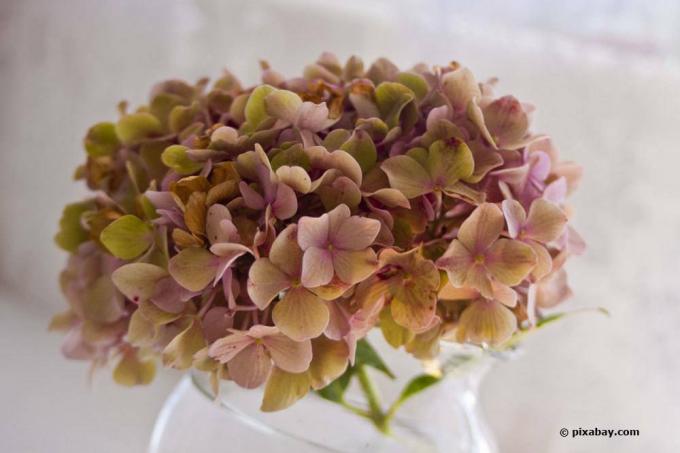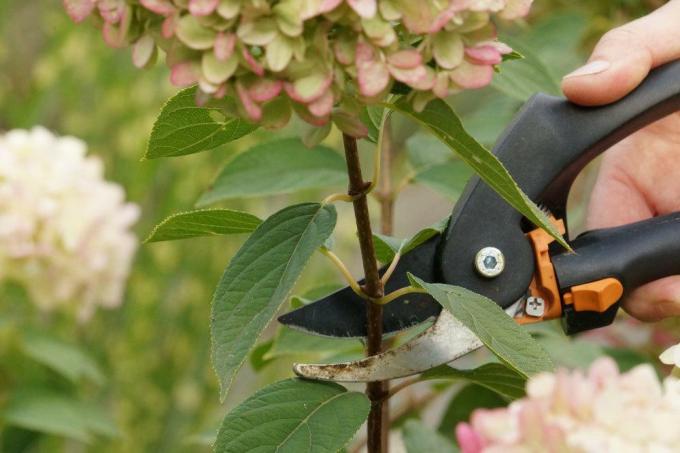
table of contents
- Cut off hydrangea flowers?
- time
- Cutting group 1
- Cutting group 2
- Break off and cut off faded hydrangeas
- Cut off what has faded
- Break off what has faded
Faded hydrangeas are always a sad sight. The popular plants inspire with their up to 20 centimeters large flowers, which are in numerous Present colors and bloom from mid-May to September as long as there are enough nutrients. When it comes to hydrangea, many gardeners consider whether it is advisable to remove hydrangea flowers or leave them on the plant. If so, should one cut off what has faded or break it off as a precaution?
Cut off hydrangea flowers?
Hydrangeas are known to carry faded inflorescences into winter. For this reason, gardeners, especially newbies, wonder whether it is advisable to remove them. The withered umbels have to can even be removed in order to stimulate the budding or the formation of new buds, because otherwise the hydrangea threatens to weaken with its flowering. In the case of the genus, you can easily cut off the hydrangea flowers with scissors, but the hydrangea plants tolerate it better if they are only broken off. However, the timing is particularly important, otherwise you will steal the winter protection from the hydrangea, which is necessary for many species.
tip: Of course you can cut them for your vase or to dry them during the flowering period, when the cones are already a bit ripe and no longer completely fresh. You can then simply hang them up or put them in the vase.

time
Never cut or break off the hydrangea inflorescences before winter. The withered acts as winter protection and protects the shoots from wind and snow. In addition, the dried up inflorescences have a decorative character, which, although colorless, fits in nicely with the season. Especially when snow collects on the cones, they are a welcome motif in photographs and distract from the dreary weather. The point in time for cutting the flowers is based on the cutting group:
Cutting group 1
The cutting date for the hydrangea of the first cutting group is early spring, around March. Since they are a little more sensitive to frost, you have to wait longer before cutting, but you will have the flowers in the garden for a longer period of time. This group of hydrangeas includes the species and their varieties:
- Farmer's hydrangea (bot. Hydrangea macrophylla)
- Plate hydrangea (bot. Hydrangea serrata)
- Rough hydrangea (bot. Hydrangea aspera)
- Velvet hydrangea (bot. Hydrangea sargentiana)
- Oak leaf hydrangea (bot. Hydrangea quercifolia)
- Climbing hydrangea (bot. Hydrangea petiolaris)
The first cutting group is already forming new buds in autumn that the hydrangeas then carry through the winter. For this reason, you must not cut off the flowers either, otherwise the flower would fail.

Cutting group 2
The cut date for faded hydrangeas of the second cut group is clear previously. The cut should take place by the end of February at the latest. If you have a sheltered location, the pruning is even possible at the end of November, which means that the hydrangeas do not have the classic winter protection of the genus. The following species and their varieties belong to it:
- Snowball hydrangea (bot. Hydrangea arborescens)
- Panicle hydrangea (bot. Hydrangea paniculata)
The difference to the first cutting group is the formation of the buds. These are not trained until the new year, which enables the cut so early. Remember not to do this too late or the bloom will fail very weakly or not at all.

tip: the blue Hydrangea macrophylla 'Endless Summer' and the white Hydrangea macrophylla 'The Bride' are an exception to this. These produce new flowers every four to six weeks over the entire summer, which requires removing the old flowers until autumn sets in.
Break off and cut off faded hydrangeas
Depending on whether you want to cut the faded cones with scissors or simply break them off, you have to pay attention to a few points. On the one hand, the cutting groups come into play here, because they determine how far the withered must be cut off:
- 1. Cutting group: directly below the flower and above the following axilla
- 2. Cutting group: these hydrangeas are completely cut back to a few centimeters above the ground
Cut off what has faded
Most of the time it is not possible to break off the hydrangea of the second cutting group with your fingers, as these are simply too tight. If this is the case, you will definitely need a pair of scissors. Proceed as follows to cut:
- choose sharp, disinfected scissors
- Rose scissors are best suited for this
- start at the appropriate point on the hydrangea, depending on the cutting group
- Cut off the faded umbel or the shoot

Break off what has faded
Do not be surprised if you can see almost no plant material on top of your hydrangeas of the second cut group. This will sprout again from spring. If you'd rather break off the blooms, do the following:
- Grip the corresponding point with your index finger and thumb
- Carefully break off the shoot to the side with a fingernail
- proceed slowly
- in this way you prevent fibers from being torn too much, which would affect the plant
Pay special attention to the types of first cutting group on not severing the withered umbel below the leaf axil. That is where the new buds are. For this reason, proceed with caution.
